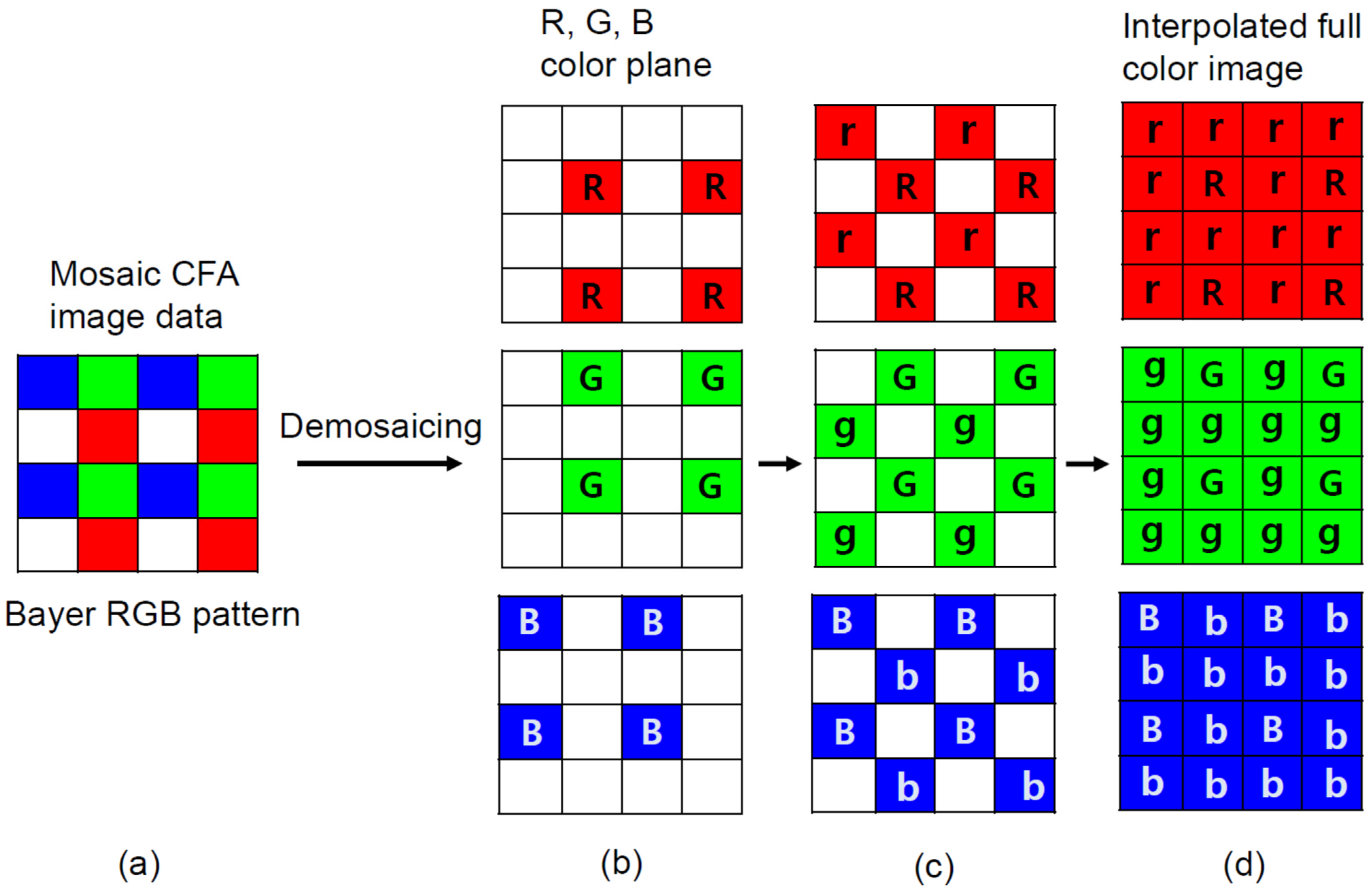Estimation of Fluor Emission Spectrum through Digital Photo Image Analysis with a Water-Based Liquid Scintillator
Abstract
:1. Introduction
2. Motivation
3. Photo Color Image Processing Analysis
3.1. Color Filter Array (CFA) Image Sensor
3.2. Color Spaces
3.3. Emission Spectrum of Fluors from a Color-Decoded Image of WbLS
3.4. Sinogram and Optical Tomography
4. Summary
Author Contributions
Funding
Institutional Review Board Statement
Informed Consent Statement
Data Availability Statement
Acknowledgments
Conflicts of Interest
References
- Lightfool, P.K.; Kudryavtsev, V.A.; Spooner, N.J.C.; Liubarsky, I.; Luscher, R. Development of a gadolinium-loaded liquid scintillator for solar neutrino detection and neutron measurements. Nucl. Instrum. Methods Phys. Res. Sect. A. 2004, 522, 439–446. [Google Scholar] [CrossRef]
- Ding, Y.; Zhang, Z.; Liu, J.; Wang, Z.; Zhou, P.; Zhao, Y. A new gadolinium-loaded liquid scintillator for reactor neutrino detection. Nucl. Instrum. Methods Phys. Res. Sect. A. 2007, 522, 238–243. [Google Scholar] [CrossRef]
- Park, K.S.; Park, J.S.; Kim, B.C.; Shin, J.W.; Ahn, J.K. Construction and properties of acrylic vessels in the RENO detector. Nucl. Instrum. Methods Phys. Res. Sect. A. 2012, 686, 91–99. [Google Scholar] [CrossRef]
- Suekane, F. An overview of the kamland 1-kiloton liquid scintillator. arXiv 2004, arXiv:physics/0404071v2. [Google Scholar]
- Back, H.O. Phenylxylylethane (PXE): A High-density, high-flashpoint organic liquid scintillator for applications in low-energy particle and astrophysics experiments. arXiv 2004, arXiv:physics/0408032. [Google Scholar]
- Alimonti, G. Light propagation in a large volume liquid scintillator. Nucl. Instrum. Methods Phys. Res. Sect. A. 2000, 440, 360–371. [Google Scholar] [CrossRef]
- Beriguete, W.; Cao, J.; Ding, Y.; Hans, S.; Karsten, M.H. Production of a gadolinium-loaded liquid scintillator for the Daya Bay reactor neutrino experiment. Nucl. Instrum. Methods Phys. Res. Sect. A. 2014, 763, 82–88. [Google Scholar] [CrossRef] [Green Version]
- Winn, D.R.; Raftery, D. Water Based Scintillators for Large Scale Liquid Calorimetry. IEEE Trans. Nucl. Sci. 1985, 32, 727–732. [Google Scholar] [CrossRef]
- Yeh, M.; Hans, S.; Beriguete, W.; Rosero, R.; Hu, L.; Hahn, R.L.; Diwan, M.V.; Jaffe, D.E.; Kettell, S.H.; Littenberg, L. A New Water-Based Liquid Scintillator and Potential Applications. Nucl. Instrum. Methods Phys. Res. Sect. A. 2011, 660, 51–56. [Google Scholar] [CrossRef]
- Fischer, V.; Tiras, E. Water-based Liquid Scintillator Detector as a New Technology Testbed for Neutrino Studies in Turkey. Nucl. Instrum. Methods Phys. Res. Sect. A. 2020, 969, 163931. [Google Scholar] [CrossRef] [Green Version]
- So, S.H.; Joo, K.K.; Kim, B.R.; Kim, B.C.; Kim, S.C. Development of a Liquid Scintillator Using Water for a Next Generation Neutrino Experiment. Adv. High Energy Phys. 2014, 2014, 327184. [Google Scholar] [CrossRef] [Green Version]
- Fischer, V. Theia: A multi-purpose water-based liquid scintillator detector. arXiv 2018, arXiv:1809.05987. [Google Scholar]
- Griffin, W.C. Classification of Surface-Active Agents by “HLB”. J. Soc. Cosmet. Chem. 1949, 1, 311–326. [Google Scholar]
- Griffin, W.C. Calculation of HLB values of non-ionic surfactants. J. Soc. Cosmet. Chem. 1954, 5, 249–256. [Google Scholar]
- David, J.T. A Quantitative Kinetic Theory of Emulsion Type, I Physical Chemistry of the Emulsifying Agent, Gas/Liquid and Liquid/Liquid Interface. In Proceedings of the 2nd International Congress Surface Activity, London, UK; 1957; Volume 1, pp. 426–438. [Google Scholar]
- Suzuki, A.; Hara, T. R&D of water-based liquid scintillator as a reactor anti-neutrino detector. arXiv 2014, arXiv:2001.02655. [Google Scholar]
- Caravaca, J.; Land, B.J.; Yeh, M.; Orebi Gann, G.D. Characterization of water-based liquid scintillator for Cherenkov and scintillaton separation. Eur. Phys. J. C 2020, 80, 867. [Google Scholar] [CrossRef]
- Ramanath, R.; Snyder, W.E.; Bilbro, G.L. Demosaicking methods for Bayer color arrays. J. Electron. Imag. 2002, 11, 306–315. [Google Scholar] [CrossRef]
- Gunturk, B.K.; Glotzbach, J.; Altunbasak, Y.; Schafer, R.W.; Mersereau, R.M. Demosaicking: Color filter array interpolation. IEEE Signal. Process. Mag. 2005, 22, 44–54. [Google Scholar] [CrossRef]
- McGregor, T.J.; Spence, D.J.; Coutts, D.W. Laser-based volumetric colour-coded three-dimensional particle velocimetry. Opt. Lasers Eng. 2007, 45, 882–889. [Google Scholar] [CrossRef]
- Anzagira, L.; Fossum, E.R. Color filter array patterns for small-pixel image sensors with substantial cross talk. J. Opt. Soc. Am. A. 2014, 32, 28–34. [Google Scholar] [CrossRef] [PubMed] [Green Version]
- CIE. Commission internationale de l’Eclairage Proceedings. 1931; Cambridge University Press: Cambridge, UK, 1932. [Google Scholar]
- Smith, T.; Guild, J. The C.I.E. colorimetric standards and their use. Trans. Opt. Soc. 1931, 33, 73–134. [Google Scholar] [CrossRef]
- Smith, A.R. Color Gamut Transform Paris. In Proceedings of the 5th Annual conference on computer graphics and interactive techniques, New York, NY, USA, 23−25 August 1978. [Google Scholar]
- Buck, C.; Gramlich, B.; Wagner, S. Light propagation and fluorescence quantum yields in liquid scintillators. J. Instrum. 2015, 10, P09007. [Google Scholar] [CrossRef] [Green Version]
- Ahn, J.K. (RENO Collaboration). An Experiment for Neutrino Oscillation Parameter theta_13 Using Reactor Neutrinos at Yonggwang. arXiv 2010, arXiv:1003.1391. [Google Scholar]
- Canon 450D XSi. Available online: https://maxmax.com/canon_450d_xsi.htm (accessed on 17 December 2021).
- Brace, R.N. Strip Integration in Radio Astronomy. Aust. J. Phys. 1956, 9, 198–217. [Google Scholar]






Publisher’s Note: MDPI stays neutral with regard to jurisdictional claims in published maps and institutional affiliations. |
© 2021 by the authors. Licensee MDPI, Basel, Switzerland. This article is an open access article distributed under the terms and conditions of the Creative Commons Attribution (CC BY) license (https://creativecommons.org/licenses/by/4.0/).
Share and Cite
Choi, J.-W.; Choi, J.-Y.; Joo, K.-K. Estimation of Fluor Emission Spectrum through Digital Photo Image Analysis with a Water-Based Liquid Scintillator. Sensors 2021, 21, 8483. https://doi.org/10.3390/s21248483
Choi J-W, Choi J-Y, Joo K-K. Estimation of Fluor Emission Spectrum through Digital Photo Image Analysis with a Water-Based Liquid Scintillator. Sensors. 2021; 21(24):8483. https://doi.org/10.3390/s21248483
Chicago/Turabian StyleChoi, Ji-Won, Ji-Young Choi, and Kyung-Kwang Joo. 2021. "Estimation of Fluor Emission Spectrum through Digital Photo Image Analysis with a Water-Based Liquid Scintillator" Sensors 21, no. 24: 8483. https://doi.org/10.3390/s21248483
APA StyleChoi, J.-W., Choi, J.-Y., & Joo, K.-K. (2021). Estimation of Fluor Emission Spectrum through Digital Photo Image Analysis with a Water-Based Liquid Scintillator. Sensors, 21(24), 8483. https://doi.org/10.3390/s21248483





